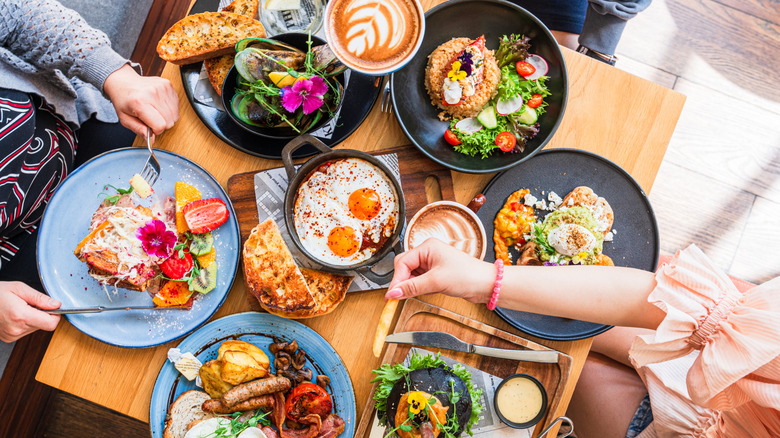The Case For Avoiding This Trendy Breakfast Item At Restaurants
We may receive a commission on purchases made from links.
There's nothing wrong with hopping on a trend when it's worth the hype. From plant-based alternatives to cooking everything in the air fryer, there's a reason food trends — like borderless cuisine – get the attention they do. But not every viral dish deserves its pedestal, especially when its price far outweighs the payoff. Case in point: the millennial icon of the 2010s, avocado toast.
Still found on brunch menus around the world, avocado toast has become a staple of café culture ... but if you ask us, it might be time to retire it. Thanks to its lasting popularity (and the high labor and transportation costs of avocados imported from Mexico or California), avocado prices have skyrocketed. In just the past year alone, large Hass avocados have jumped more than 75% in cost. However, that doesn't justify the fact that coffee shops and breakfast joints are charging $10 to $20 for a slice of bread topped with sliced or smashed avocado (or god forbid, a pre-made guacamole-like avocado spread). Sure, part of that covers service and labor, but when you can make the same dish at home for $5 or less, it's hard to rationalize — especially when you consider that avocado is best when enjoyed immediately, and you can probably make a tastier, fresher version at home yourself.
And nutritionally, avocado toast doesn't deliver much bang for your buck. While avocados are rich in monounsaturated fats, the meal doesn't provide much protein (only 4 to 5 grams per serving). That means you'll be leaving brunch $20 down and still hungry. Of course, you can add eggs on top for extra protein, but at that point, why not just order an omelet or scramble instead?
The rise and fall of a food trend
Avocado toast may have become the brunch world's mascot in the 2010s, but its story started long before it went viral on social media. Australian chef Bill Granger is often credited with putting it on the map in the 90s, but avocados have been a staple in Mexican and South American cuisine for centuries. Still, it wasn't until the social media era that avocado toast transformed from a simple breakfast to a $20 dish with seven different garnishes.
And its rise to popularity can likely be correlated to the increased attention to health and wellness in the food world over the past few decades. When Gwyneth Paltrow featured her own version in her 2013 cookbook "It's All Good," others quickly began making and reposting it, fueling the fire. At its core, avocado toast fits perfectly into an aesthetic lifestyle that people want to replicate. It's self-perpetuating: People ordered it because everyone else did, and everyone else did because it looked so good on their feed. Restaurants caught on, adding photogenic garnishes — arugula, walnuts, tomatoes — to make it look worthy of the price.
Now, we aren't saying we're anti-avocado toast at Food Republic. In fact, I often enjoy making it at home with a slice of high-quality bread. Plus, it's customizable: You can elevate it with creamy ricotta cheese, add flavor with various seasonings, or, in my case, drizzle on some top-tier balsamic vinegar. Our case isn't against the toast; it's against paying $20 for it at a restaurant and leaving unsatisfied.


